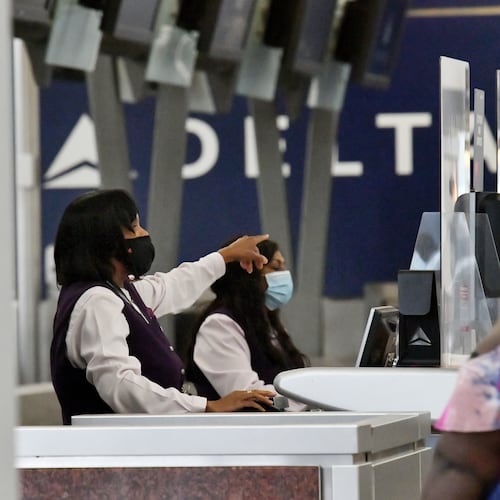Modern-day life keeps getting faster, but fast food is slowing down.
In an industry that traditionally measures every second, wait times have soared over the last 15 years at quick-service restaurants.
The culprit is the drive-through — the line of choice for about 70 percent of hungry and often-rushed visitors to fast-food chains. Wait times there grew as customers demanded better, fresher foods and items more difficult to prepare.
“We’ve almost quit doing fast food because they are not fast food any more,” stay-at-home mom Michelle Hancock said as she idled her pickup at a McDonald’s drive-through in Duluth, waiting for a couple of cheeseburgers and fries.
Hancock and her husband are eating out less often because of the costs and the growing time commitment.
Purveyors of hamburgers, chicken sandwiches and milkshakes are scrambling to catch up, rethinking everything from how drive-through operations are laid out to what workers say to customers or where they meet and serve them. Some staffers at Atlanta-based Chick-fil-A are now hustling outside not only to take orders but to deliver food, bypassing the drive-through window.
Chick-fil-A’s drive-through times between ordering and receiving food are closing in on double its average in 2003. At 260.85 seconds last year, it ranked second slowest of 10 major chains studied, according to QSR magazine, a trade publication that clocks them annually.
Industry giant McDonald’s was longest at 273.29 seconds, about two minutes slower than 2004. Wendy’s added nearly as much time and now sits at 226.07 seconds. Taco Bell, at 236.50, is about a minute and a half slower. Burger King, the speedster of the group at 193.31 seconds, is 40 seconds behind its decade-ago time.
Those figures don’t include how long motorists wait before ordering — lines can stretch around buildings during crunch times.
McDonald’s, the nation’s largest fast-food chain by revenue, said it can’t stomach any more after five years of increasing times. It’s adding technology to help staffers flag bottlenecks. “We expect to actually reduce service times across 2019,” Chief Executive Steve Easterbrook recently told analysts.
Avoiding the red zone
Chains raced to make drive-through service as fast as possible in the early 2000s, but order accuracy declined as a result, according to Sam Oches, editorial director of Food News Media, which publishes QSR.
Consumers also wanted more menu offerings, adding complexity to food preparation and lengthening wait times. That's despite juiced-up technology, improved kitchen design and more workers assigned to the drive-through.
It’s a tough balancing act.
Valencia Sherman, a single mother, said she’s almost always racing against the clock to grab lunch and take care of errands on her midday break as an Atlanta child care teacher. Still, “if I want the quality food, I wait,” she said.
Others won’t hang around. If lines look too long at one drive-through, human resources recruiter Ramonda Coleman said she makes a snap decision: “I go to the next shortest line place.”
Chick-fil-A is adding windows and doors at some restaurants so staff can bring food to waiting vehicles more quickly. And it’s planning to attach removable shelves alongside the drive-through so outside workers can stage food before hand delivering it, said Khalilah Cooper, the director of service and hospitality.
The chain is adding canopies with fans and heaters over drive-through lanes to improve work conditions for the staffers stationed outside — all the while trying to ensure they feel safe while navigating around moving cars.
During a recent lunch rush at a Chick-fil-A on Northside Drive in Atlanta, restaurant operator John Diamond saw pending drive-through orders highlighted in red on a kitchen monitor. They had slipped over the three-minute goal he set for service time.
“We don’t want to be in the red,” he said.
Another Chick-fil-A he operates on Howell Mill Road has a two-minute goal because the limited space around the restaurant for cars is “a hot mess,” forcing the line of vehicles to sometimes wrap around the building twice.
Set against the pace is the competing goal of treating customers right and having a personal connection. “We want fast, friendly and accurate, but not rushed,” Diamond said.
Lunchtime in the drive-through is a daily symphony at the Northside Drive restaurant, with seven outside workers, including four order-takers spread out over two lines.
Another member staffs an outside register. One carries orders to cars before they get to the takeout window. A co-worker is inside at the window — what they call the cockpit — handing out food. A manager is nearby directing motorists.
Inside, more workers are glancing at the drive-through clock, filling drinks and preparing meal orders that are bigger, and more sophisticated and customized than 20 years ago. That limited-time Frosted Key Lime lemonade? It took an extra 30 or 40 seconds to prepare.
Arby’s scrutinizes ingredients, Krystal eyes delivery services
Other chains face the same pressures.
When Arby's drive-through times peaked in 2015, "we said we have to start getting our arms around this," said John Kelly, the chain's chief operating officer. But at the same time, locally based Arby's is "not going to dumb down the quality of our product to be fast."
The company built a “complexity model” to assess the time it takes to prepare every ingredient in every sandwich. The model helps company officials determine whether a sandwich is worth the commitment. That’s a big deal for a chain that dramatically expanded its menu from roast beef to include six different proteins, multiple breads and a lineup of limited-time items added every six to eight weeks.
Arby’s staff also delays suggesting order additions to avoid slowing customers who already know what they want. And the chain is weighing a system to take customers’ spoken orders, somewhat like Amazon’s Alexa virtual assistant.
Krystal, the Dunwoody-based chain that serves tiny, square burgers, has begun spending heavily to rebuild or renovate some restaurants. At one on Moreland Avenue in Atlanta, a recent $1-million-plus upgrade focused on a new look inside and out and, crucially, on improving drive-through efficiency.
The restaurant reconfigured the food prep area to end beside the drive-through window, and space was added to fit three workers there. Speed per order improved 20 to 30 seconds, which helped contribute to a 30 percent boost in sales, said Paul Macaluso, Krystal’s chief executive.
Macaluso also is bullish about the potential of third-party delivery services such as Uber Eats and DoorDash to get food into customers’ hands. And Krystal plans to launch mobile ordering for customer pickup at all restaurants by the end of the year.
McDonald's rolled out the mobile-order option nationally in 2017. Customers order through an app, park in designated spots at a restaurant, and the food is delivered to their car.
But many in the industry want to prevent such changes from complicating navigation around the drive-through lanes.
The lines, they figure, already are long enough.
About the Author
Keep Reading
The Latest
Featured



